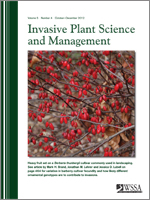Producers facing infestations of invasive annual grasses regularly voice the need for practical revegetation strategies that can be applied across broad landscapes. Our objective was to determine the potential for scaling up the single-entry approach for revegetating medusahead-infested rangeland to broader, more heterogeneous landscape-scale revegetation of winter annual grass–infested rangeland. We hypothesized, when applied on a highly variable landscape scale, the combination of imazapic and seeding would provide highest abundance of perennial grasses and lowest amount of annual grasses. Treatments included a control, seeding of crested wheatgrass (‘Hycrest’) and Sandberg's bluegrass, spraying (60 g ai ha−1 imazapic), and a simultaneously applied combination of spraying and seeding. The HyCrest and Sandberg's bluegrass seeding rates were 19 and 3.4 kg ha−1, respectively. The treatments were applied to large plots (1.4 to 8 ha) and replicated five times, with each replication located in different watersheds throughout southeastern Oregon. This study shows that the single-entry approach can be scaled up to larger landscapes, but variation within establishment areas will likely be high. This procedure should reduce the costs over multientry treatment applications and make revegetating annual grass–infested rangeland across landscapes more affordable.
Nomenclature: Imazapic, medusahead, Taeniatherum caput-medusae (L.) Nevski, crested wheatgrass, Agropyron cristatum (L.) Gaertn. × Agropyron desertorum Gaertn. ‘Hycrest’, Sandberg's bluegrass, Poa secunda J.S. Presl
Management Implications: Managing invasive annual grass infestations on a large scale remains a major impediment for successful rangeland restoration. The high cost of treatments and low percentage of success often keep managers from initiating management plans where large-scale infestations are present. In this experiment, we utilized a single-entry treatment of herbicide application and seeding on landscape-scale plots of medusahead- and cheatgrass-infested rangeland. We were interested in determining whether this method would provide acceptable levels of control for the invasive grasses and establishment of desired species. Our results suggest that the one-pass system might be a suitable method for restoring invasive annual grass infestations and lower the cost of treatment by completing an herbicide application and seeding in a single entry into the field.





